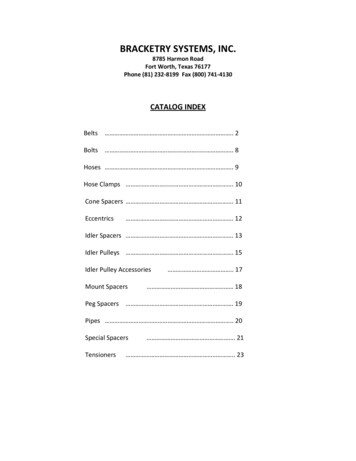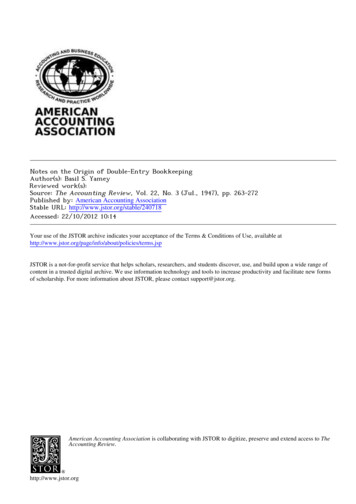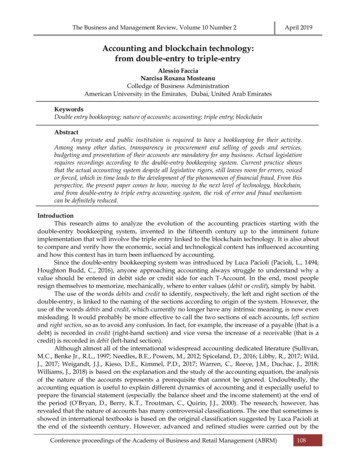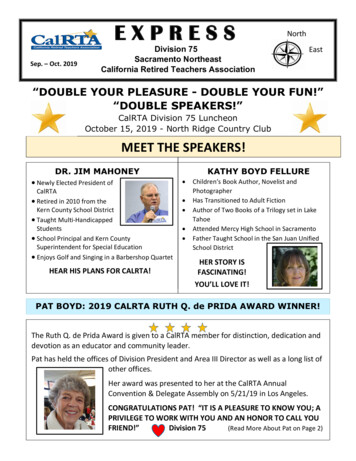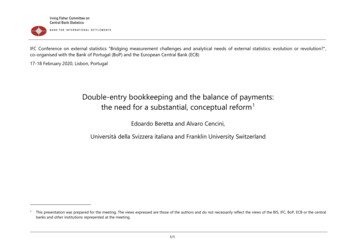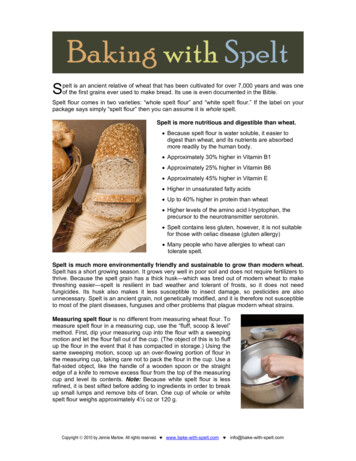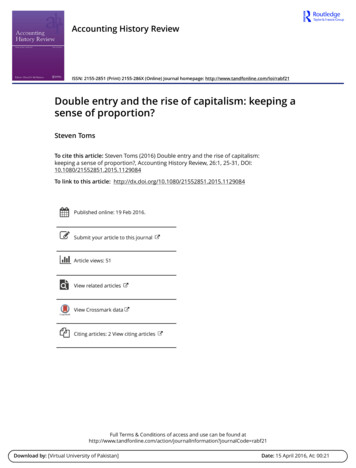
Transcription
Accounting History ReviewISSN: 2155-2851 (Print) 2155-286X (Online) Journal homepage: http://www.tandfonline.com/loi/rabf21Double entry and the rise of capitalism: keeping asense of proportion?Steven TomsTo cite this article: Steven Toms (2016) Double entry and the rise of capitalism:keeping a sense of proportion?, Accounting History Review, 26:1, 25-31, DOI:10.1080/21552851.2015.1129084To link to this article: lished online: 19 Feb 2016.Submit your article to this journalArticle views: 51View related articlesView Crossmark dataCiting articles: 2 View citing articlesFull Terms & Conditions of access and use can be found tion?journalCode rabf21Download by: [Virtual University of Pakistan]Date: 15 April 2016, At: 00:21
ACCOUNTING HISTORY REVIEW, 2016VOL. 26, NO. 1, 9084Double entry and the rise of capitalism: keeping a sense ofproportion?Steven TomsDownloaded by [Virtual University of Pakistan] at 00:21 15 April 2016Leeds University Business School, University of Leeds, Leeds, UKABSTRACTARTICLE HISTORYThe paper addresses the debate raised by the reinterpretation ofDean, Clarke, and Capalbo (2016) of the origins of double-entrybookkeeping (DEB) and its implications. It offers a critique basedon three aspects: the role of value, the relationship between DEBand algebra, and the historical sequencing of the adoption ofDEB, the rise of capitalism and the ‘capitalist mentality’,industrialisation and the Global Financial Crisis. It reinterprets eachaspect and concludes on the implications for teaching, stressingthe importance of all aspects of asset valuation.Received 20 August 2015Accepted 22 October 2015KEYWORDSDouble-entry bookkeeping;rise of capitalism; GlobalFinancial Crisis; PacioliIntroductionDean, Clarke, and Capalbo (2016) have written a thought-provoking interpretation of therelationship between innovation in art and accounting, and its historical consequences. Indoing so, they illustrate the importance of researching and teaching the context of doubleentry bookkeeping (DEB). They also offer a potentially important interpretation of theorigins of DEB and its subsequent history.That DEB was part of the broader intellectual movement of the Renaissance is unquestionable. Indeed it would be most surprising had the Italian ‘many-sided men’ of the fifteenth century1 neglected the study the commercial aspects of mathematics. As Dean,Clarke, and Capalbo (2016) show, there is a clear association between algebraicmethods in commerce and Pacioli’s presentation of DEB in his Summa (1494 [1914]).Then as now, DEB promotes good management and assists decision making. All ofthese are fair and reasonable speculations; they form a useful basis for further investigation into the nature and origins of DEB, which will surely be of substantial interest tomost accounting historians.Some of that interest will undoubtedly take the form of debate, which at this stage atleast, can be centred on some of the more questionable assertions of the paper. These are,first, that the sense of proportion that inspired the discovery and adoption of DEBsomehow disappeared in the Global Financial Crisis (GFC). In making this assertion,Dean, Clarke, and Capalbo (2016) only deal implicitly with issues of (mis)valuation,which is, arguably, the defining feature of the GFC. Second, there are claims about the derivation of DEB from the use of algebraic solutions to bartering problems. Although the parallels between these techniques are clear, their historical sequencing is open to question.CONTACT Steven Toms 2016 Taylor & Francisj.s.toms@leeds.ac.uk
26S. TOMSIn similar vein, the third point of issue is about the origins of DEB and its relationship to therise of capitalism suggested in the Dean, Clarke, and Capalbo (2016) paper, particularly theimplied causes and effects. These issues are dealt with in turn, together with a conclusionthat also engages with a further point, which is the implication for the teaching ofaccounting.Downloaded by [Virtual University of Pakistan] at 00:21 15 April 2016Value, DEB and the GFCAlthough it is true that financial bubbles and crises imply some loss of proportionality,their consequences are manifested in disproportionate asset valuations and extraordinaryleverage, not in disproportionate applications of the method of DEB. Valuation decisionsthus provide input values for DEB, and, because such decisions were crucial in the GFC,Dean, Clarke, and Capalbo (2016) need to offer a more explicit accommodation of therole of value. Only then can we interpret the GFC as an abandonment of the Renaissanceprinciple of proportionality.We can note that Italian merchants and banks in the GFC both used DEB. The differencein the GFC seems to be that firms using the same rules did not report comparable results.Why not? According to Dean, Clarke, and Capalbo (2016), flexible valuation rules inaccounting standards allowed such outcomes to occur, for example fair value accounting(17). Their important critical observation, in making this point, is that rules using expectational input data were institutionalised during the GFC. As a consequence, Renaissancestyle balance and proportionality were ‘nowhere to be seen’ (17). Where the lack ofbalance occurs in DEB terms is not however made clear in their paper. The adoption offair value accounting does not in itself undermine balance and proportionality. Changingthe value of an asset concurrently changes the value of the residual claims upon it, ifnormal DEB is applied, and by the same virtue, produces a balanced account. In suchfashion, strict DEB proportionality, as defined by Dean, Clarke, and Capalbo (2016), isretained, even at the height of a financial crisis.The Dean, Clarke, and Capalbo (2016) paper implies, however, that in the GFC assetswere valued disproportionately. The exact nature of the disproportion is difficult to ascertain. It could be that the values used in the GFC were disproportionate to some underlyingvalue, but without identifying the nature of that value and how it is captured by Renaissance DEB methods, the disproportion cannot be specified. Alternatively, it may be thatthere is considerable disproportion in the valuation decisions taken by the cross sectionof firms, but again, that would be a matter of speculation. Or did Renaissance merchantsuse accounting in such a way that accommodated the normal subjectivities associatedwith valuation? In summary, two questions remain to be answered: how does fair value,or any other valuation rule, undermine Renaissance (or modern) DEB, or in the world ofthe GFC, where there is DEB and disproportion, and how might DEB deal with misvalued assets?A useful extension to the argument of Dean, Clarke, and Capalbo (2016) would be to consider what Pacioli himself says about valuation. In Summa (1494 [1914]), he directly considers the valuation issue and its relation to the accounting entries. For example, hesuggests that estimation is needed to determine the value of non-cash inventory items.In his example of the exchange of wool for pepper (1494 [1914], 79), he proposes an estimation of the value of pepper for the purpose of establishing the amounts of the debit
ACCOUNTING HISTORY REVIEW27and credit ledger entries. In other words, however, valued, accurately or no, DEB preservesproportionality. However, if in the GFC investors could be misled by AAA ratings on financialassets, by the same token, could the wool valuation in Pacioli’s example also be incorrect (forinstance by a misrepresentation about the grade of wool)? In Pacioli’s wool and pepperexample, as in the GFC, the problem of valuation precedes the decision of how values arethen accounted for. The method of accounting does not of itself resolve the valuation issue.Downloaded by [Virtual University of Pakistan] at 00:21 15 April 2016Commerce, algebra and DEBDean, Clarke, and Capalbo (2016, 18) state that duality is meaningless without the algebraic context provided by Pacioli. Examples are given by Dean, Clarke, and Capalbo(2016, 10) of the type of problem, like bartering, that could be solved using algebra.Here the authors identify a potentially important relationship between the use ofalgebra in bartering and the development of DEB. However, the one does not necessarilyimply the other. In bartering transactions, algebra would be used to establish value equivalence. It would not require DEB per se. As Heeffer puts it (2011, 116): ‘There is probably noneed for algebra in performing bookkeeping operations but for complex bartering operations or the calculation of compound interest, basic knowledge of arithmetic was mandatory and knowledge of algebra was very useful.’On this basis, we can conclude and agree that there was an association betweenalgebra and DEB. What Heeffer (2011, 121) however also shows is that Renaissance commercial arithmetic used proportions to arrive at equivalent values for the purposes ofbarter, incorporating profit margins on the transaction. Once calculated, DEB provided aconsistent method of recording these proportions, divided for example into cash, bartervalue and profit. The evidence therefore seems clear that algebra and DEB sharedcommon principles, but the implied relationship between algebra and commercial practice is less obvious. Heeffer’s conclusion also suggests that there is no necessity toteach algebra in association with DEB.There is a further question mark over the implied chronology. According to Dean,Clarke, and Capalbo (2016) with reference to commercial barter, the proportion puzzlewas solved by della Franscesca (11). By contrast, Heeffer (2011, 123) dates the applicationof algebra for the solution of bartering transactions to Mazzinghi in the 1380s. Even at thatdate, the requirement to compute exchange ratios between commodities of differentquantities and qualities was long standing, giving rise to labour-based theories of valueand prices determined by custom and practice.DEB, accounting history and the rise of capitalismHaving established and contextualised the development of DEB in the intellectual climateof Renaissance Italy, Dean, Clarke, and Capalbo (2016) then go onto describe how a platform was thus created for the capitalist mentality, to some extent based on the interpretation offered by Bryer (2000a, 2000b, 2005). However, an alternative sequence of eventscould also be suggested. Ancient societies rely solely on barter, and therefore requirerules to determine the exchange equivalence of different combinations of goods and services. Such requirements lead to the institutionalisation of trading rules and prices, such asthe notion of the ‘just price’, that can be subjected to arbitration (De Roover 1958). The
Downloaded by [Virtual University of Pakistan] at 00:21 15 April 201628S. TOMSidea of just price relies upon proportionality by equating value to the labour required toproduce a particular item and can be viewed as an extension of the use of barter-basedratios. Algebra then provides a mathematical solution to the need for fair valuation of combinations of commodities, like ginger and sugar, which require exchange in ratios that alsoaccommodate cash elements and transaction-based mark-ups. Finally, recognising thattransactions might be split between cash, barter and profit elements, and featurecontra entries, DEB emerges as the logical solution.In such a version of events, the development of mathematical proportion was a necessary condition for economies based on bartering. This logic follows because understandingof proportion is required for the equation of value in a transaction, for example two hidesequal five loaves of bread. Plato and the ancient Greeks understood this, and by deductionso did earlier, barter-dependent societies. Mathematical understanding of proportion thennecessarily predates both Renaissance art and Pacioli’s description of DEB. Pacioli’s DEB ofcourse goes beyond barter-based ratios, but given the long history of proportionality infinancial transactions, it is not clear why proportionality in art is necessary for the development of DEB interpreted as a system of proportionality.Returning to the GFC, we can now pose the counterfactual question: would the use ofRenaissance-style methods and sense of proportion have prevented it? Certainly anappealing feature of medieval business practice in this respect was that custom and practice evolved such that Catholic Thomist and feudal principles of fair or just prices were wellknown and the methods of establishing value equivalence were similarly based on customary profit rates at transaction level (Toms 2010; see also Grassby 1969; Tawney1926). By contrast with such regular trades, evolving over long periods, in observable commodity-type products, at the centre of the GFC were newly devised, thinly traded, complexand difficult to value assets, which were often traded over the counter, most notably, collateralised debt obligations. In the absence of established market prices, valuations werebased only on the estimated cash-flow-generation capacity of the assets themselves. Inshort, few of the institutionalised trading mechanisms and norms of Renaissance Italywere present. Similarly there was often no mechanism for establishing third-party priceequivalence, and no reference point as to what represented a fair profit on the transaction,and so on. The only mechanism actually used was DEB, suggesting the conclusion that ofall the senses of proportion abandoned in the GFC, the proportion implied in DEB was notone of them.In the intervening period between the Renaissance and the GFC, Dean, Clarke, andCapalbo (2016, 16) argue that DEB’s new representation of proportionality promotedthe ‘capitalist mentality’ through the development of commerce and then the industrialrevolution. The accounting-specific view suggested here, in line with Bryer (2000a,2000b) is that DEB promoted profitability-style calculations. However, as Toms (2010)demonstrates, none of the examples provided by Bryer cite a return-on-capitalemployed-style calculation in the modern sense. That would include the type suggestedby Dean, Clarke, and Capalbo (2016, 15): ‘to evaluate the amount and profitability oftheir business investment ’. The other source mentioned in the quote, Stephens(1735, 4), does refer to the ‘Value and Condition of his Estate’, but the purpose of sucha computation, when the passage is read in context, is not to calculate profitability.Rather it is to monitor the separate components of assets and liabilities and their interrelationship such that default risk can be ascertained and perhaps avoided. Stephens’s
Downloaded by [Virtual University of Pakistan] at 00:21 15 April 2016ACCOUNTING HISTORY REVIEW29concern arises from the character of barter-style transactions (in this case equivalents ofcash obligations, sugar and tobacco) similar to those addressed by Pacioli and it is forthis reason, as the subsequent text illustrates, that he finds Pacioli’s approach useful. Inboth cases it is true, as Dean, Clarke, and Capalbo (2016) argue, that DEB is an innovationthat promotes good management and facilitates decision making. As they suggest (16),there is a need for reliable periodic reporting as a result of ownership changes. It isworth noting that Pacioli (1494 [1914], 41) also stressed the need for such reporting. Herelated the advantages of his method for the purpose of custody and institutional scrutinyof merchants’ books of account. However, the anachronistic use of words like profitabilityto infer ‘capitalist mentality’ is a step too far when merchants were actually using DEB topromote the objectives described by Pacioli, and thus to facilitate transactions arising fromthe trading rules and customs that prevailed in early modern Europe.Such trading rules, and their evolution, should be borne in mind when reading theaccount of Dean, Clarke, and Capalbo (2016) of the history of accounting as communication from the sixteenth century to the first half of the nineteenth century. Here theysuggest that it is DEB itself that ‘encourages’ the ‘capitalist mentality’ because of its ‘potential to show how to increase capital through profitable activities’ (16). However profitswere, as Crosby (1997) points out, embedded in individual transaction prices (see alsoDean, Clarke, and Capalbo 2016, 12; Heeffer 2011), and as the examples given byGrassby (1969) illustrate, with the rate of profit on any given transaction governed bythe feudal norms and customs of the just price and restrictions on usury (Tawney 1926).The argument that DEB promotes the capitalist mentality also does not sit well with thelogic or evidence of the industrial revolution. Dean, Clarke, and Capalbo (2016, 16) doacknowledge that the development of industrial technology gives rise to new problemsand poses new challenges that go beyond DEB. Accordingly, there are now the seedsof ‘modern capitalism’, but this would suggest that the ‘capitalist mentality’ is not a sufficient condition for capitalism per se, or that it mutates through time. It might seem anuanced point, but do we conclude that DEB gives rise to capitalism as suggested bySombart (1902) and Bryer (2005), or that it is down to the factors that Dean, Clarke, andCapalbo (2016) point out that were identified by Adam Smith as defining characteristicsof capitalism, like the division of labour? Or might it be the case that accountingmethods reflect the organisation of production as much as the capitalist mentality? It isan important question to evaluate, if the conclusion of Dean, Clarke, and Capalbo(2016) that, ‘[W]ithout the consequential financial order (provided by DEB), capitalismmay have failed ’ (18) is to be supported.Dean, Clarke, and Capalbo (2016) may thus speculate about comparisons with profitand capital being facilitated by DEB. There is, however, no evidence that calculationsusing ratios of the business’s total profit to its total capital occurred much before 1800or even 1850. Indeed, economists like Scrope (1833) and Ramsay (1836), only began to theorise the notion of a general rate of profit on capital in the 1820s and 1830s, again as aresponse to industrialisation.A counter argument that accommodates the dimensions of capitalist mentality andindustrial organisation introduced by Dean, Clarke, and Capalbo (2016) is the view thataccounting and accounting change are the effects, rather than the causes of capitalist,or indeed any other form of economic development. According to this view, accountingevolves in response to the development of the asset base and changes in capital
30S. TOMSownership (Toms 2010; Toms and Fleischman 2015), and in that sense could be describedas a proportionate phenomenon in history.Downloaded by [Virtual University of Pakistan] at 00:21 15 April 2016ConclusionsIn summary, the development of aggregate financial profitability ratios was not closelyintegrated into the development of DEB as a system of proportional relationships. Moreover, given the long history of proportionality in financial transactions, it is not clear whyproportionality in art is necessary for the incorporation of proportion into DEB.To conclude definitively on the relationship between DEB and capitalism is beyond thescope of the present discussion, but certainly Dean, Clarke, and Capalbo (2016) have raisedan interesting new angle, which should be the subject of debate. As their paper illustrates,the story of DEB and capitalism is an important bridge between the Renaissance and theGFC. However, the interpretation suggested by Dean, Clarke, and Capalbo (2016) of therelevance of Pacioli and proportion to the mistakes of the GFC depends very much onthe similarities and differences between the two eras.In my view, the key difference lies in the nature of the rules that applied in the two eras.The accounting standards that are critiqued by Dean, Clarke, and Capalbo (2016, 17) couldcertainly be contrasted with the rules about limited transaction-based profits and associated social condemnation of excess profits that prevailed in the Renaissance. Othermatters, such as the use of estimation to ascertain asset values, the use of accounts formonitoring and control, or the algebraic equality upon which they are predicted seemcommon, if not perennial, features of accounting.Taken together, these issues raise question marks about how our teaching should bemodified. Certainly understanding the context in which accounting techniques aredevised and modified is absolutely crucial. Achieving this outcome would better equip students with the technical aspects of DEB and a deeper understanding of events like theGFC. How the teaching of DEB itself should be changed, however, is unresolved. Certainlythe tone of my critique above is that valuation issues should be emphasised, philosophically, historically and technically. The better the understanding of that issue the more theaccountants of the future will be sceptical about models suggesting values that although‘fair’, are nonetheless disproportionate. In that sense, the issues raised by Dean, Clarke, andCapalbo (2016) can be guaranteed to have a lasting contribution.Note1. For Burkhardt (1860 [2010], 85), ‘The fifteenth century is, above all, that of the many-sided men.’Disclosure statementNo potential conflict of interest was reported by the author.ReferencesBryer, R. A. 2000a. “The History of Accounting and the Transition to Capitalism in England. Part One:Theory.” Accounting, Organizations and Society 25 (2): 131–162.
Downloaded by [Virtual University of Pakistan] at 00:21 15 April 2016ACCOUNTING HISTORY REVIEW31Bryer, R. A. 2000b. “The History of Accounting and the Transition to Capitalism in England. Part Two:Evidence.” Accounting, Organizations and Society 25 (4): 327–381.Bryer, R. A. 2005. “A Marxist Accounting History of the British Industrial Revolution: A Review ofEvidence and Suggestions for Research.” Accounting, Organizations and Society 30 (1): 25–65.Burkhardt, J. 1860 [2010]. The Civilization of the Renaissance in Italy. New York: Dover.Crosby, A. W. 1997. The Measure of Reality: Quantification in Western Europe, 1250-1600. London:Cambridge University Press.Dean, G., F. Clarke, and C. Capalbo. 2016. “Pacioli’s Double Entry – Part of an Intellectual and SocialMovement.” Accounting History Review 26 (1): 5–24.De Roover, R. 1958. “The Concept of the Just Price: Theory and Economic Policy.” The Journal ofEconomic History 18 (4): 418–434.Grassby, R. 1969. “The Rate of Profit in Seventeenth-century England.” English Historical Review, 84(333): 721–751.Heeffer, A. 2011. “On the Curious Historical Coincidence of Algebra and Double-entry Bookkeeping.”In Foundations of the Formal Sciences VII. Bringing Together Philosophy and Sociology of Science,edited by K. Francois, B. Lowe, T. Muller, and B. van Kerkhove, 109–130. London: CollegePublications.Pacioli, L. 1494 [1914]. “Summa de Arithmetica, Geometria, Proportioni et Proportionalita.” In AncientDouble Entry Bookkeeping, edited by J. B. Geijsbeek, 33–81. Denver: J.B. Geijsbeek.Ramsay, G. 1836. An Essay on the Distribution of Wealth. Edinburgh: A. and C. Black.Scrope, G. P. 1833. Principles of Political Economy. London: Longman, Rees, Orme, Brown, Green, &Longman.Sombart, W. 1902. Der Moderne Kapitalismus: Bd. Die Genesis des Kapitalismus (Vol. 1). Leipzig:Duncker & Humblot.Stephens, H. 1735. Italian Book-Keeping Reduced into an Art. London: W. Mears.Tawney, R. H. 1926. Religion and the Rise of Capitalism (Vol. 23). London: Transaction publishers.Toms, J. S. 2010. “Calculating Profit: A Historical Perspective on the Development of Capitalism.”Accounting, Organizations and Society 35 (2): 205–221.Toms, S., and R. K. Fleischman. 2015. “Accounting Fundamentals and Accounting Change: Boulton &Watt and the Springfield Armory.” Accounting, Organizations and Society 41 (1): 1–20.
Double entry and the rise of capitalism: keeping a sense of proportion? Steven Toms Leeds University Business School, University of Leeds, Leeds, UK ABSTRACT The paper addresses the debate raised by the reinterpretation of Dean, Clarke, and Capalbo (2016) of the origins of double-entry bookkeeping (DEB) and its implications. It offers a .



